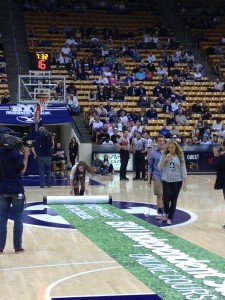Advertisements placed in the restrooms at the Marriott Center by BYU Athletic sponsors and partners hang on the walls six days a week but must come down on Sundays.
“When we wanted to put advertisements in the bathrooms at the Marriott Center; we got the OK,” said BYU assistant athletic director Danny Almodova. “We were just told they had to come down on Sunday for devotionals. Also, we won’t just put up any sponsor. We need to make sure we are in compliance with what the school stands for.”

BYU, as famous for its stand against playing inter-collegiate games on Sunday as it is for its outstanding teams, takes its religious mission seriously, and the athletic department is not exempted.
“Every college athletic department (including BYU) is a self-sustaining entity,” Almodova said. “The difference is that we are a religious institution. Athletics is part of the overall mission of BYU.” That mission is dictated by the university’s sponsor, The Church of Jesus Christ of Latter-day Saints.
Thus, when a marketing scheme or potential corporate partner is discussed within BYU Athletics, the athletic department has more to consider than the typical college athletic department. The department must make sure that the partner’s business and the proposed marketing plans are compatible with BYU standards.
Almodova explained the process that occurs at BYU when the athletic department wants to implement a new plan.
Almodova and the rest of BYU’s Athletic staff must submit their plans to BYU Campus Planning for approval on any major sports marketing campaign.
Campus Planning is a group of BYU vice presidents that report to President Samuelson and make sure all the individual organizations throughout BYU are staying true to the university’s overall mission.
Almodova stressed that the athletic department has a “great relationship” with Campus Planning.
“Campus Planning is not a separate entity,” Almodova said. “They are just another step in the process. Their job isn’t to say ‘no’ on all of our ideas. It is for them to look at the plan and give the final ok.”
The recent seating change of the student section at LaVell Edwards Stadium provides a good example of the unique planning process that occurs at BYU.
Previously, unlike most college stadiums throughout the nation, Edwards Stadium seating arrangements had students scattered throughout the stadium. To create a more unified student section, BYU Athletics had to undergo a longer process than other universities without religious affiliation.
“We talked about changing the student section four years ago,” Almodova said. “However, to change student seating we had other things to consider. We couldn’t move the band to the south of the stadium because the noise reached the temple grounds. Our goal was to create a unified student section, and we slowly started the process.”
While BYU is subsidized and funded by the Church, BYU Athletics receives no money from the Church to help run its programs.
“We have to be self-sustaining,” Almodova said. “We receive no tithing funds. That is why we fundraise, sell tickets, solicit private donations and have corporate partnerships.”
Almodova stated that because BYU is a private, religious institution, financial information is not disclosed to the public. However, Almodova did say that BYU Athletics has an annual budget of around $40 million.
“We are kind of in the middle,” Almodova said when asked to compare BYU’s budget to other major universities. “Most of the BCS (Bowl Championship Series) schools, budgets will start anywhere from $60 million and go up. If you’re looking at just Division I schools, out of 123 we are in the middle or a little below the middle.”
According to an official press release from the University of Utah, the average budget in the Pac-12 Conference is $63.5 million.
BYU student Kyle Andrews, an avid sports fan from Texas, said he enjoys the different emphasis placed on sports at BYU compared to other schools.
“I grew up around a lot of Texas fans, and all they care about is football and sports,” Andrews said. “I like how at BYU we care about our athletics but it isn’t what we focus on. BYU has more important goals than having the best sport programs or biggest athletic budget.”




